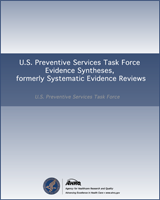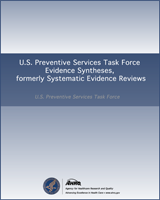NCBI Bookshelf. A service of the National Library of Medicine, National Institutes of Health.
This publication is provided for historical reference only and the information may be out of date.
Structured Abstract
Background:
In 2004, the U.S. Preventive Services Task Force (USPSTF) recommended against screening asymptomatic persons in the general population for hepatitis B virus (HBV).
Purpose:
To systematically review the current evidence on the benefits and harms of screening for HBV infection in asymptomatic nonpregnant adolescents and adults.
Data Sources:
We searched the Cochrane Central Register of Controlled Trials (through January 2014), the Cochrane Database of Systematic Reviews (2005 through January 2014), Ovid MEDLINE® (1946 through January 2014), and PsycINFO® (1806 through January 2014) and reviewed reference lists of relevant articles.
Study Selection:
We included randomized trials of screening and treatment that reported intermediate or clinical outcomes. We also included observational studies of screening and on the association between improvement in intermediate outcomes after antiviral therapy and improvement in clinical outcomes.
Data Extraction:
One investigator abstracted data, and a second investigator checked data abstraction for accuracy. Two investigators independently assessed study quality using methods developed by the USPSTF.
Data Synthesis (Results):
We found no direct evidence on effects of screening for HBV infection versus no screening on clinical outcomes. HBV vaccination was associated with decreased risk of HBV acquisition in high-risk populations. Data from randomized trials suggest that antiviral therapy may be more effective than placebo for reducing risk of clinical outcomes associated with HBV infection, but differences were not statistically significant and pooled estimates were imprecise due to small numbers of events. Evidence consistently found antiviral therapy to be more effective than placebo or no treatment for various intermediate histological, virological, biochemical, and serological outcomes. Results were generally consistent when analyses were stratified by individual drug. Limited evidence from head-to-head trials found that entecavir and pegylated interferon alfa-2a had greater likelihood of achieving intermediate outcomes than lamivudine. Studies on the association between improvements in intermediate outcomes following antiviral therapy and clinical outcomes were heterogeneous and had methodological limitations, precluding strong conclusions. Antiviral therapy was associated with a higher risk of withdrawal due to adverse events than placebo, but there was no difference in risk of serious adverse events.
Limitations:
We included only English-language publications. Studies conducted in countries where the prevalence and natural history of HBV infection differ from those in the United States were included due to limited evidence from settings more applicable to practice in the United States. Evidence from placebo-controlled trials on intermediate and clinical outcomes was limited or not available for some first-line antiviral therapies.
Conclusions:
Although screening tests can accurately identify adolescents and adults with chronic HBV infection, more research is needed to understand the effects of screening and subsequent interventions on clinical outcomes and to identify optimal screening strategies. The declining incidence and prevalence of HBV infection as a result of universal vaccination programs is likely to impact future assessments of the benefits and harms of HBV screening.
Contents
- 1. Introduction
- Purpose and Previous U.S. Preventive Services Task Force Recommendation
- Condition Definition
- Prevalence and Burden of Disease
- Etiology and Natural History
- Risk Factors/Indicators
- Rationale for Screening and Screening Strategies
- Interventions and Treatment
- Current Clinical Practice
- Recommendations of Other Groups
- 2. Methods
- 3. Results
- Key Question 1 What Are the Benefits of Screening for HBV Versus No Screening in Asymptomatic, Nonpregnant Adolescents and Adults on Morbidity, Mortality, and Disease Transmission?
- Key Question 2 What Are the Harms of Screening for HBV Infection (e.g., Labeling, Anxiety, and Harms of Confirmatory Tests, Including Biopsy)?
- Key Question 3 How Well Do Different Screening Strategies Identify Individuals With HBV Infection (e.g., Strategies That Target Persons From High-Prevalence Countries, Men Who Have Sex With Men, Injection Drug Users, Immunization History, or Other Risk Factors)?
- Key Question 4 In Nonpregnant Adolescents and Adults With No Evidence of HBV Immunity on Screening, How Effective Is HBV Vaccination for Improving Clinical Outcomes?
- Key Question 5 In Nonpregnant Adolescents and Adults With Chronic HBV Infection, How Effective Is Antiviral Treatment at Improving Intermediate Outcomes (Virological or Histological Improvement or Clearance of HBeAg)?
- Key Question 6 In Nonpregnant Adolescents and Adults With Chronic HBV Infection, How Effective Is Antiviral Treatment at Improving Health Outcomes?
- Key Question 7 In Nonpregnant Adolescents and Adults With Chronic HBV Infection, How Effective Is Education or Behavior Change Counseling in Reducing Transmission and Improving Health Outcomes?
- Key Question 8 What Are the Harms Associated With Antiviral Treatment for HBV Infection?
- Key Question 9 Do Improvements in Intermediate Outcomes Improve Final Health Outcomes?
- 4. Discussion
- References
- Appendix A Detailed Methods
- Appendix B Evidence and Quality Tables
Acknowledgments: The authors acknowledge the AHRQ Medical Officer, Iris Mabry-Hernandez, MD, MPH, as well as the U.S. Preventive Services Task Force Leads, Kirsten Bibbins-Domingo, PhD, MD; Mark Ebell, MD, MS; Doug Owens, MD, MS; and Albert Siu, MD, MSPH.
Prepared for: Agency for Healthcare Research and Quality, U.S. Department of Health and Human Services1, Contract No. HHSA-290-2007-10057-I, Task Order 13. Prepared by: Pacific Northwest Evidence-based Practice Center2
Suggested citation:
Chou R, Dana T, Bougatsos C, Blazina I, Zakher B, Khangura J. Screening for Hepatitis B Virus Infection in Nonpregnant Adolescents and Adults: Systematic Review to Update the 2004 U.S. Preventive Services Task Force Recommendation. Evidence Synthesis No. 110. AHRQ Publication No. 12-05172-EF-1. Rockville, MD: Agency for Healthcare Research and Quality; 2014.
This report is based on research conducted by the Pacific Northwest Evidence-based Practice Center (EPC) under contract to the Agency for Healthcare Research and Quality (AHRQ), Rockville, MD (Contract No. HHSA-290-2007-10057-1, Task Order Number 13). The findings and conclusions in this document are those of the authors, who are responsible for its contents, and do not necessarily represent the views of AHRQ. Therefore, no statement in this report should be construed as an official position of AHRQ or of the U.S. Department of Health and Human Services.
The information in this report is intended to help health care decisionmakers—patients and clinicians, health system leaders, and policymakers, among others—make well-informed decisions and thereby improve the quality of health care services. This report is not intended to be a substitute for the application of clinical judgment.
This report may be used, in whole or in part, as the basis for development of clinical practice guidelines and other quality enhancement tools, or as a basis for reimbursement and coverage policies. AHRQ or U.S. Department of Health and Human Services endorsement of such derivative products may not be stated or implied.
None of the investigators has any affiliations or financial involvement that conflicts with the material presented in this report.
- 1
540 Gaither Road, Rockville, MD 20850; www
.ahrq.gov - 2
Oregon Health & Science University, Mail Code: BICC, 3181 SW Sam Jackson Park Road, Portland, OR 97239; www
.ohsu.edu/epc
- Review Screening for Hepatitis B Virus Infection in Nonpregnant Adolescents and Adults: A Systematic Review for the U.S. Preventive Services Task Force[ 2020]Review Screening for Hepatitis B Virus Infection in Nonpregnant Adolescents and Adults: A Systematic Review for the U.S. Preventive Services Task ForceChou R, Blazina I, Bougatsos C, Holmes R, Selph S, Grusing S, Jou J. 2020 Dec
- Review Screening for hepatitis B virus infection in adolescents and adults: a systematic review to update the U.S. Preventive Services Task Force recommendation.[Ann Intern Med. 2014]Review Screening for hepatitis B virus infection in adolescents and adults: a systematic review to update the U.S. Preventive Services Task Force recommendation.Chou R, Dana T, Bougatsos C, Blazina I, Khangura J, Zakher B. Ann Intern Med. 2014 Jul 1; 161(1):31-45.
- Review Lipid Screening in Childhood and Adolescence for Detection of Familial Hypercholesterolemia: A Systematic Evidence Review for the U.S. Preventive Services Task Force[ 2016]Review Lipid Screening in Childhood and Adolescence for Detection of Familial Hypercholesterolemia: A Systematic Evidence Review for the U.S. Preventive Services Task ForceLozano P, Henrikson NB, Dunn J, Morrison CC, Nguyen M, Blasi PR, Anderson ML, Whitlock E. 2016 Aug
- Review Screening for Hepatitis B Virus Infection in Nonpregnant Adolescents and Adults: Updated Evidence Report and Systematic Review for the US Preventive Services Task Force.[JAMA. 2020]Review Screening for Hepatitis B Virus Infection in Nonpregnant Adolescents and Adults: Updated Evidence Report and Systematic Review for the US Preventive Services Task Force.Chou R, Blazina I, Bougatsos C, Holmes R, Selph S, Grusing S, Jou J. JAMA. 2020 Dec 15; 324(23):2423-2436.
- Review Lipid Screening in Childhood for Detection of Multifactorial Dyslipidemia: A Systematic Evidence Review for the U.S. Preventive Services Task Force[ 2016]Review Lipid Screening in Childhood for Detection of Multifactorial Dyslipidemia: A Systematic Evidence Review for the U.S. Preventive Services Task ForceLozano P, Henrikson NB, Morrison CC, Dunn J, Nguyen M, Blasi P, Whitlock EP. 2016 Aug
- Screening for Hepatitis B Virus Infection in Nonpregnant Adolescents and AdultsScreening for Hepatitis B Virus Infection in Nonpregnant Adolescents and Adults
Your browsing activity is empty.
Activity recording is turned off.
See more...

